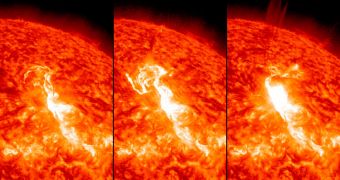Experts managing the NASA Solar Dynamics Observatory (SDO) mission have just released a series of images and a short video, depicting a strong storm that has been taking place on the surface of the Sun over these past few days.
The star is ramping up its activity after a long period of calm, ramping up for a new maximum in its recurring, 11-year cycle. The peak is scheduled to be reached between late 2012 and 2013, solar physicists explain.
According to the SDO team, the new storm is so intense that it may affect communications, power grids and satellites here on Earth. At the same time, the massive influx of electrically-charged particles is bound to cause a brightening of auroras.
This particular flare was observed at 0327, 0342, and 0412 GMT on January 23, by the Atmospheric Imaging Assembly (AIA) aboard the SDO. The actual event was preceded by an impressive brightening of the solar surface.
The latter was caused by superheated and magnetically supercharged gas, which eventually triggered the release of a huge stream of solar matter (as depicted in the third image). The coronal mass ejection will also reach Earth, experts say.
SDO classified the eruption as an M 8.7-class event, which is just below the threshold for the X-class, the most powerful solar flares the Sun is capable of producing. The stream matter the star released will cause the most intense solar energetic particle storm in the last 7 years, when it reaches Earth.
This prediction was made by experts at the NOAA Space Weather Prediction Center. The NASA Solar Terrestrial Relations Observatory (STEREO) and the European Space Agency's (ESA) Solar and Heliospheric Observatory (SOHO) spacecraft confirmed the SDO readings.
The solar matter cloud is currently traveling at a speed of about 2,000 kilometers (1,400 miles) per second, and is estimated to reach our planet today, January 24. Tomorrow, the cloud is bound to reach Mars as well.
Heliophysicists say that occurrences such as this are bound to become increasingly common as we are nearing the peak of the current solar cycle. However, there is currently no way of knowing just how intense these events will be.
“I would expect that we will see more storms like this one or even bigger as we get closer to solar maximum,” explains the chief of heliophysics research at the NASA Goddard Space Flight Center (GSFC), in Greenbelt, Maryland, Michael Hesse.

 14 DAY TRIAL //
14 DAY TRIAL // 